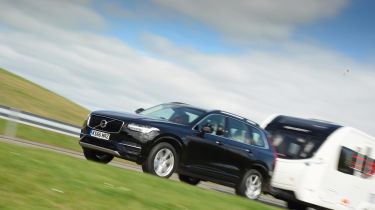Towing capacity explained: how much can my car tow?
There’s a limit to how much your car can tow – we cover what you need to know about towing capacities

If you’re planning to tow a caravan or trailer with your car, it’s important to understand the rules surrounding towing capacity. Not every car can tow, but those that can will have a maximum weight limit outlined by the manufacturer and by law.
A car’s towing capacity is the maximum load that it can safely tow. Knowing this figure is crucial if you plan on towing – a car with a 1,000kg capacity will be fine for many small and mid-size trailers, though it will be wholly unsuitable if you need to haul a 1,500kg caravan. There are other weight figures to consider, too, along with road gradients and weight distribution, all of which are covered below.
What is a towing capacity?
Towing capacity is the maximum weight that a car is able to tow, quoted in kilograms (kg). The figure is provided by the manufacturer for a specific model and can be found in the car’s handbook, although not every car will have one. Typically, city cars and sports cars won’t have an official towing capacity as they’re not designed to be used for towing, whereas a 4x4 is almost guaranteed to have one.
It’s vital not to exceed this limit – towing more than the stated towing capacity puts you at risk of losing control of your vehicle.
Towing capacities can vary between different versions of the same car, depending on engine size, gearbox type, and whether the model has four-wheel drive. If you’re researching the towing capacity for a car you plan to buy, make sure it’s for the exact model and engine combination you want.
As a general rule, cars with big, powerful engines and four-wheel drive make the best tow cars and have the highest towing capacities. But there are other factors at play, too – a 300bhp Land Rover will certainly make a better tow car than a 700bhp Ferrari – so always check the manufacturer’s quoted towing capacity. If you need a good starting point, we regularly update our list of the best tow cars on the market.
No car will have a quoted towing capacity greater than 3,500kg. This is the maximum legal ‘braked’ towing capacity in the UK. For ‘unbraked’ trailers, this reduces to 750kg – but what’s the difference?
What’s the difference between braked and unbraked towing capacity?
There are two types of trailers that you can tow: a braked or an unbraked trailer. As the name suggests, braked trailers have their own set of brakes that work in tandem with the car’s, whereas unbraked trailers have to rely solely on the car.
Manufacturers will quote a separate maximum towing capacity for braked and unbraked trailers, and the latter will usually be much lower. This is because an unbraked trailer is harder to control than a braked one.
Your car’s unbraked and braked towing capacities are usually listed on your car’s VIN plate, typically located on most cars’ driver’s side door sill. You may also find your car’s towing capacities in the owner’s manual, and in the Practicality section of our reviews. If you’re still struggling to find the towing weights, your car’s manufacturer should be able to tell you what they are. If no figures are listed, it means the car isn’t deemed suitable for towing at all.
Maximum trailer lengths and widths
It’s not just payload capacities that you need to consider when towing a heavy load. There are also legal restrictions on the size of the trailer you’re allowed to tow with your car, regardless of whether the towing load itself complies with the limits.
The widest your trailer is legally allowed to be is 2.55 metres, with the maximum length of a trailer with a payload up to 3,500kg being seven metres. For the length restriction, this doesn’t include the trailer’s A-frame – this is a part at the front of the trailer with a shape that resembles a capital A when viewed from above, and is where the tow hitch is located.
Towing capacities on gradients
Towing a heavy trailer can affect how a car behaves when driving up and down steep gradients. With all of that extra weight behind the car, there’s more strain on the engine when going uphill, and it can be harder to control the car when heading downhill.
For that reason, you need to be aware of any steep gradients on your journey when you’re towing. As a rule of thumb, the maximum towing figures for a car will be valid for gradients of up to 12%, though this may vary depending on the manufacturer – check your car’s owner’s manual to see if this is the case for your car.
We recommend plotting your route out beforehand if you plan to tow a heavy trailer, avoiding any inclines and descents greater than 12% (or the manufactuer’s quoted figure) – especially if you’re not far off your car’s maximum towing capacity.
Nose weights when towing
When you’re towing with your car, one figure you’ll need to consider is the ‘nose weight’. This is the load that the trailer exerts onto the towbar of your car when stationary. Each car will have a maximum nose weight limit, and this should be listed in the owner’s manual.
The nose weight of your trailer or caravan is important to bear in mind, as the amount of weight being forced down onto the tow bar can have an impact on your car’s handling. For example, too much weight will force the rear of the car down, which by extension lifts the front of the car up and affects your car’s steering.
Conversely, too little weight over the tow bar could be an indication the weight balance of your towed load is too rear-biased. All that weight located out back will mean your car can become harder to control in crosswinds, and increase the chances of your trailer swinging from side-to-side (more commonly referred to as ‘snaking’).
Driving made simple...
Recommended

Classic car tax exemption: which historic vehicles qualify?
Most Popular
Tips & advice

Car dashboard warning lights: what does each symbol mean?

Electric car charging stations: public networks, charger types, apps and maps








